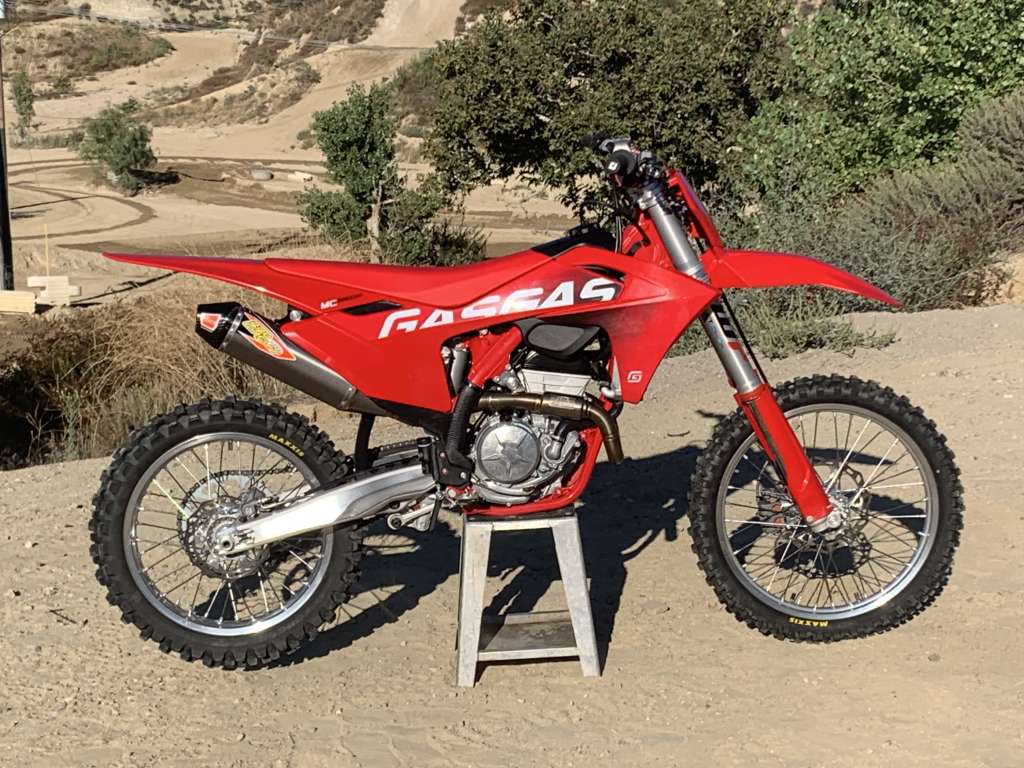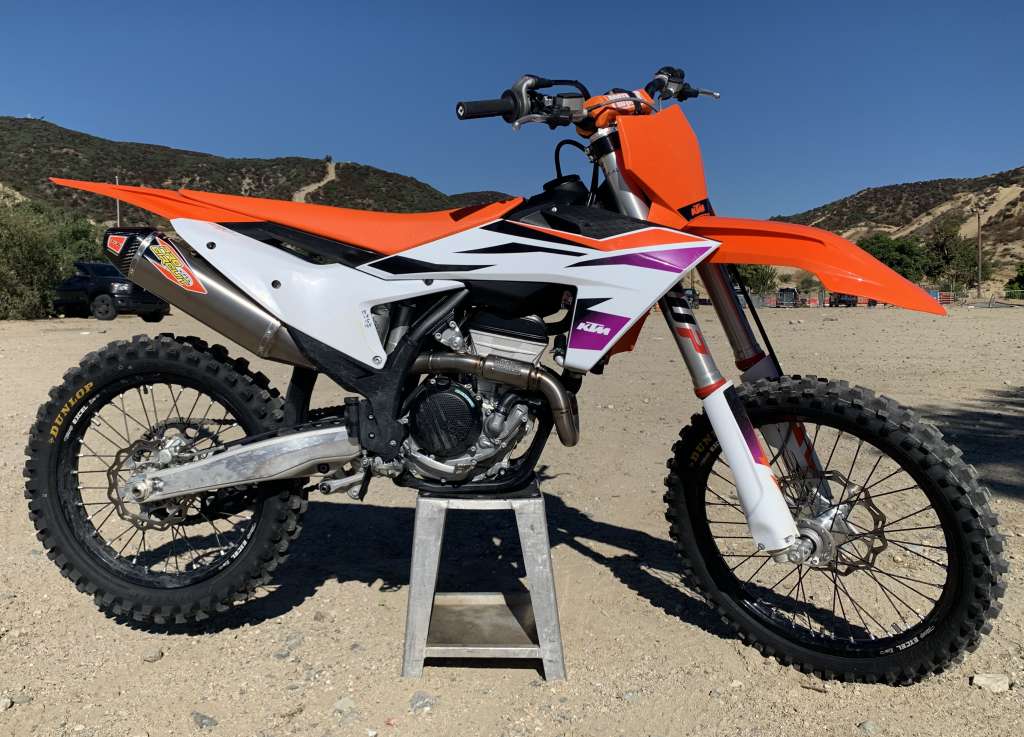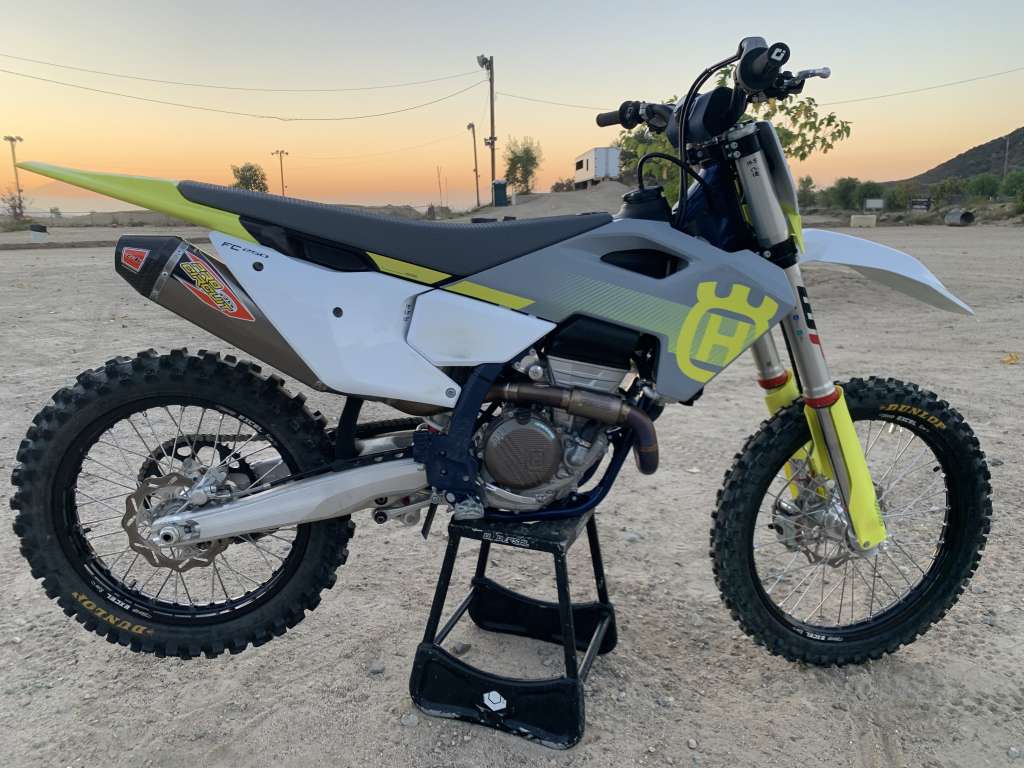Share This Article
Written By: Gardner Tarlow
Austrian triplets! Can you really go wrong?
For 2024 all three of the Austrian bikes although different in color took on very similar personalities.
For 2024 the Gas Gas MC250F is all new from its 2023 predecessor, and although all new for Gas Gas it’s basically the red headed triplet with two somewhat identical siblings, KTM and Husky. The 2024 KTM and Husqvarna except for a few slight tweaks in suspension are basically the same bikes as the 23 version but now they have a third sibling with blood red hair, and damn, if she’s a girl, she’s hot looking. Having just finished testing the 2024 KTM 250SXF, Husqvarna FC250 and GG MC250F, some may be curious if the so-called economy more affordable Gas Gas version would be up to par with its siblings. All three euro bikes have variances from each other but the major components such as the frame, swingarms, suspension, general ergos and motor are all very similar. Although the Gas Gas does “not” come stock with a map switch, the map switch can be added for a minimal fee. Other variances are different tires, bars, brakes, clutch, triple clamps, plastic design and air box configuration. For me the biggest difference in the three bikes on the track is the personality of the motors which I think is greatly affected by the air box configuration. The Husqvarna’s suspension is also 10mm shorter compared to KTM and GG which results in 1” lower saddle which for a rider 5’9” or smaller may be a deal maker or changer. Some of the differences I noticed between KTM, Husqvarna and Gas Gas on the track I think could have been foreseen looking at the engineering design of the air box, but more on that later.

From an ergonomic point of view all three bikes have a very similar feel and would be hard to tell the difference sitting on them if you were blind folded. I am 5’10” and 190 lbs and the rider triangle to me is very comfortable and does not feel small on any of the three Euro bikes including the Husqvarna. I am not a big fan of any of the somewhat flat stock bar bends but they are all very similar despite being different branded bars. The GG bars are slightly taller but still shy of what I prefer. Seat texture is present on both KTM and Husqvarna and the GG seat is traditional smooth. All three bikes have a good transition when diving into corners and being able to get up tight on the tank. The KTM and Husqvarna have Brembo brakes and the GG has Brake Tech brakes. In my opinion Brembo brakes provide the best performance available. On the track the Brake Tech brakes are very similar in performance to the Brembo. I imagine for top amateurs and pros they might notice a difference between the Brembo and Brake Tech, however I did not appreciate a significant difference for myself. With that being said, the Brake Tech brakes still felt better than any unmodified stock versions used on other competitors. The new Brake Tech hydraulic clutch is much improved from previous versions and performs very similar to the Brembo. The clutch engagement can at times feel a bit vague when feathering the clutch out of corners compared to the Brembo, however this did not affect overall performance to any significant degree for my riding skills. New for the GG are the improved forged aluminum triple clamps that offer more flex and forgiveness with the front end compared to the KTM/Husqvarna. Although not the CNC machined triple clamps on the KTM/Husqvarna they are much improved over the 2023 GG clamp version in feel through corners.
I received each bike with less than 1 hour of break in time. I started with factory suspension stock settings and sag with all three bikes and with the exception of a few tweaks on each bike they all performed as expected. Each bike was a bit harsh early on but any harshness of forks and frame improved by the six hour mark with all three bikes. I was bit surprised by the GG and the level of harshness I felt early on with the fork and frame compared to the KTM and Husqvarna seeing how they are basically the same setup with GG supposedly having slightly softer (Euro setting) suspension valving to begin with. All three bikes I backed off the recommended fork air pressure by 3-4psi during the break in period as well as compression to smooth out the small bump harshness until about the six hour mark at which point all three bikes became more calm and compliant. Once broken in the air forks improve in performance in both small square edge bumps as well as big hits, the fork is very predictable and rideable. The newer forks all seem to resist bottoming better than years past and I would not avoid an Austrian bike because of historical past air fork performance. One note on air forks if you are new to them is to be sure to not only set the fork air pressure at the start of each day but also check the air pressure throughout the day as the pressure will increase as the forks heat up giving you the sense of a stiffer fork spring. Also, just like a spring fork you need to bleed the forks between motos for optimal performance.

If you’ve ridden previous generation versions of these bikes, the 2023-24 new chassis, shock and repositioned shock mount which promotes anti squat effects definitely improves handling and cornering of these newer 23-24 generation frames. The bikes all set up very well with lean angle entering into section 1 of the corner, I feel the anti squat effect of the rear end as you roll onto the throttle in section 2 and 3 really improved my consistency in my corners. All three bikes excelled in rutted corners but felt a bit vague on flat or off camber corners without any type of a berm to lean or press into. I’m not certain if this was a bike issue as much as a tire issue across the board. I am very much a front end steering rider and rely on front end traction. I am not a huge fan of any of the stock front tires on any of the three bikes. They are all acceptable; however there are better options when it becomes time to replace from a pure performance perspective. Hard landings, braking bumps as well as acceleration chatter bumps coming out of corners performed well with all three bikes. Straight-line high-speed stability was good for all three bikes however on the Husqvarna I occasionally experienced high speed acceleration headshake from the bike. The Husqvarna chain required the chain block adjuster to be pushed significantly more forward than the other two bikes and this very well could have been the cause.
Although both the KTM and Husky come with a map switch with both normal and aggressive maps as well as traction control, launch control and quick shift, with the exception of wanting to experience the more aggressive green map and possibly launch control I don’t know how much I would use the maps. The GG in normal setting without the map switch felt very comparable to the KTM and Husqvarna green maps and without head to head testing the GG still feels very worthy. This map switch can be purchased for less than $150 and the GG is set up stock to accept the switch as plug in and play.

The motors in stock setting are all very similar. All three bikes have very linear power with good bottom end, decent mid range and a nice pulling top end. Without interpreting dyno results, I felt the KTM had the best overall power then Husqvarna followed by the GG. The KTM bottom end felt the cleanest and robust with a healthy mid/top end. Even though the GG did not have a green map I felt its bottom end was cleaner than the Husqvarna. The GG and Husqvarna were similar in mid and top end performance with the Husqvarna maybe having better top end pull over the GG. The most noticeable difference was the KTM got into a corner with sloppy conditions in area two and three of a rut or when you found yourself in the wrong gear the bike would just bog slightly yet a quick fan of the clutch would bring the bike alive and correct the error. Both the Husqvarna and GG had a few episodes on sloppy track days where both bikes would bog and blubber and would not recover well. According to my friends there is an easy fix for this issue, “Don’t be in the wrong gear”. As much as that is true, the KTM didn’t struggle with that effect. I am not a tech guy but I believe the restricted air flow with the different air boxes and possible mapping played a role with this issue and should be easy to improve with better airflow.
Speaking to the air box issues in stock form, the KTM has the best air flow, GG is second and Husqvarna is a distant third. The KTM design has inlet flow from the top of the filter coming from both sides of the bike and circulates from the large intakes below the seat side rails in what looks like grab thru handles. The GG has intakes from both sides within the upper side plates but the ports themselves are somewhat restricted. The Husqvarna is very restricted in stock form (with air intake from a single left lower side panel opening) and even that intake in stock form has obstruction as if it were for riding in inclement weather. I know what you’re thinking and yes, I own a drill, tin snips and a utility blade if I wanted to start cutting, but we are evaluating stock set ups. If you’re a filter checker the KTM filter is seeing distributed air all around it as there is no single area of localized dirt appreciated on the filter even with multiple rides. The GG can have a bit of localized dirt on each side but also has general distributed dirt on the filter. The Husqvarna in stock form is extremely localized dirt to a very small percentage of the filter and because of this; filter changing is required more frequently. All of this restricted air flow in turn plays a role in the performance and personalities of these motors.
Pro Circuit Ti-6 Muffler Comparison:
Pro Circuit provided us a PC Ti-6 full headpipe and muffler to test on each bike. The PC pipe is definitely a great looking pipe and if you are looking to shed weight, this is a good choice. Performance benefit on all three bikes was very similar with the bottom end snap and corner to corner performance being better with the stock pipes. With the PC system the KTM bottom end and snap was very similar to the stock pipe with the stock being slighter better, the mid range seemed about the same with some slight improvement in the top end and over rev with the PC pipe. The Gas Gas bottom end was better with the stock system, the mid range was very similar between the PC/stock and the top end/over rev seemed slightly better with the PC system. The Gas Gas bottom end issue and ability to recover out of corners was not improved but was not made worse with the PC system. The Husqvarna probably benefited the most on top end but also suffered a bit on the bottom end. The bottom end was cleaner with the stock Husqvarna system and potentially worse with the PC regarding the bog/dirty feel effect. The mid range was a bit stronger with the PC pipe and the top end/over rev also was slightly improved with the PC system. I really like the look of the Pro Circuit pipe but I don’t believe this would be my first purchase to add to any of these bikes. I think a vortex ignition and addressing the air intake on the GG/Husqvarna would be a better use of funds for these two bikes. Obviously as parts wear out or become damaged, this Pro Circuit system would near the top of my choices as a replacement pipe.
I think all three of these bikes can serve the purpose for any level of motocross enthusiast. The reality is if you’re a top amateur/pro your bike is purchased stock and then quickly modified. All three of these bikes can be modified to perform at pro level. For the average Joe however, most of us will ride the bike as is and replace parts as they wear out or become damaged. You can’t go wrong with any of these Austrian bikes. Pick your color and enjoy yourself.
Retail MSRP:
KTM 250 SX-F $10,199
Husky FC250F $10,299
Gas Gas MC250F $9,399
